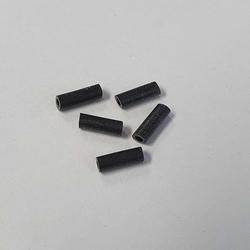Violin and Viola Bridges & bridge protectors.
Need a replacement violin or viola bridge? Learn about different types of bridges, find the right size and material, and browse our range of top-rated brands.
Bridge Vellum. Pack of two
Two pre-cut thin pieces of vellum for gluing on the bridge under the E or A string. Avoids the need to use bridge protectors typically included with E strings which ... read more...
Our price from £2.40
Choose OptionString sleeve, protective tubes Pack of 5
Rubber string protectors. To support the 'E' string at the bridge which prevents the string from cutting into the bridge groove. Also protects the string, ensuring l... read more...
Our price £1.99
More DetailsStradpet - Titanium Bridge Protectors
Titanium bridge protector clips, designed to extend the contact area between the string and the bridge and reduce the pressure on the upper edge of the bridge, thus pr... read more...
Our price from £11.99
Choose OptionPedi - Titanium Bridge Protector
Easy to use, clip on bridge protectors, no tools or glue needed. Pedi’s Titanium bridge clip makes your bridge last longer by stopping from the string cutting. Custom... read more...
Our price £12.85
More DetailsUnfitted Violin Bridges by Aubert, France
Unfitted violin bridges by Aubert, Mirecourt, France. High quality blank violin bridge by Aubert. Treated for hardness and colour. Aubert France - ideal for student... read more...
Our price from £6.78
Choose OptionUnfitted Violin bridges by Despiau - V13
Despiau offers four standards of wood quality, the most prestigious of which will carry the three-tree stamp of authenticity. The V13 represents the entry level of Des... read more...
Our price from £6.78
Choose OptionFitted Violin Bridge by Aubert, France
Bridges designed to fit the instrument without adjustment and with string grooves made. These high quality bridges are made by the the world's leading bridge maker,... read more...
Our price £9.48
Choose OptionAubert Self Adjusting Violin Bridges
Premium quality French made bridges which feature swivelling feet to provide a good fit to any instrument without further adjustment. A cost effective solution for s... read more...
Our price £21.54
Choose OptionUnfitted Viola Bridges by Aubert, France
Quality unfitted blank bridges from France's oldest established bridge maker. Various grades suitable for student instruments to the finest old master violas. Standa... read more...
Our price from £8.40
Choose OptionUnfitted Violin bridges by Despiau - V11
This model is where the variation in wood quality first comes into play , the most prestigious of which will carry the three-tree stamp of authenticity. The V11 repre... read more...
Our price from £11.62
Choose OptionHow do I put a violin bridge on?
To fit a violin bridge, ensure it is centred between the f-holes and aligned with the strings. The feet of the bridge should sit flat on the violin's surface. It's essential not to experiment with positioning, as incorrect placement can affect sound quality and playability.
For detailed guidance, refer to our easy-to-follow
video guide on fitting a violin bridge.
How do you make a violin bridge?
Violin bridges are handcrafted by skilled luthiers using specialised tools. This process requires precision to ensure the bridge fits the violin perfectly, making it unsuitable for DIY attempts by most musicians.
Are violin and viola bridges the same?
No, violin and viola bridges are different. Viola bridges are wider and thicker to accommodate the instrument's larger size and string spacing. Choosing the correct bridge is crucial for optimal sound and performance.
What happens if a violin bridge falls?
If a violin bridge falls, the strings lose support. The bridge must be repositioned correctly to restore proper sound production and playability.
Why are violin bridges not glued?
Violin bridges aren't glued because they need to move slightly to adjust to string tension changes. They're held in place by string tension and the violin's natural shape, allowing for flexibility without risking damage.
Can I play the violin without a bridge?
No, you cannot play a violin without a bridge. The bridge supports the strings and transfers vibrations to the violin’s body, which produces sound. Without a bridge, the violin cannot generate proper sound and the strings will lie against the fingerboard.


















